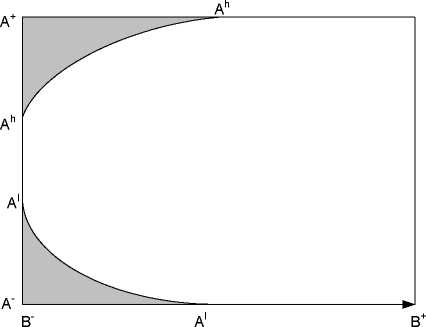∂W
ди
в+ а+
U ɔ / /
в- A1
[(F - аК)] dAdB
в+ а+
B- A1
[и (FK
- а) Ки] dAdB
f (и (F‘
аК ‘ ) df}
д ди J
dT(20)
∂W
да
ZB+ A+ B+ A+
J [иК] dAdB + H'J J [и (Fκ - а) Ka] dAdB
h 'C (и (f l
аКl) ɪɔ dB
' да
(21)
The solution is the well-known result, that investment should not be distorted:
а = 1, knowing that in this case it is Fκ — а = 0 and Fl — аКl = 0. The
government sets the tax rate so that the marginal utility of the public good equals
the marginal utility of private consumption: H' = U' (Samuelson condition).
3.5 Optimal tax policy with mobile firms
Now assume that A1 < Ah < A+, i.e. there are some firms which will produce
abroad. In this case, the equilibrium can be illustrated as in figure 2:

Figure 2: Mobile firms.
In addition to the firms which are not profitable enough to produce at all
(bottom left), there are now firms which prefer producing abroad (top left). Only
firms in the non-shaded area produce domestically an can be taxed by the domestic
11
More intriguing information
1. The name is absent2. Methods for the thematic synthesis of qualitative research in systematic reviews
3. The name is absent
4. A Unified Model For Developmental Robotics
5. Inflation Targeting and Nonlinear Policy Rules: The Case of Asymmetric Preferences (new title: The Fed's monetary policy rule and U.S. inflation: The case of asymmetric preferences)
6. Does Market Concentration Promote or Reduce New Product Introductions? Evidence from US Food Industry
7. References
8. Examining the Regional Aspect of Foreign Direct Investment to Developing Countries
9. Concerns for Equity and the Optimal Co-Payments for Publicly Provided Health Care
10. Parallel and overlapping Human Immunodeficiency Virus, Hepatitis B and C virus Infections among pregnant women in the Federal Capital Territory, Abuja, Nigeria